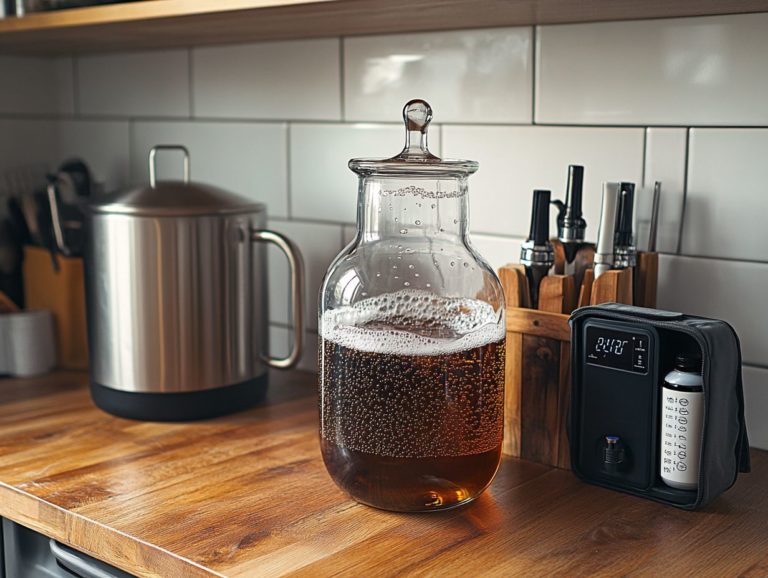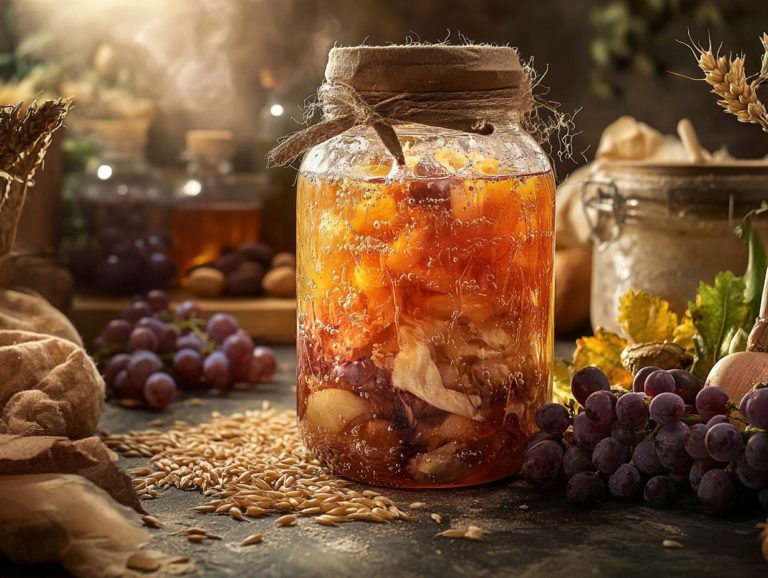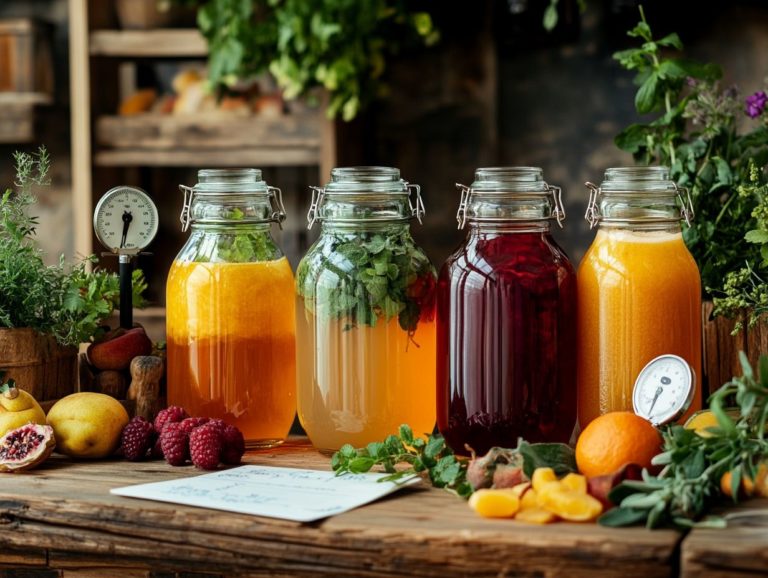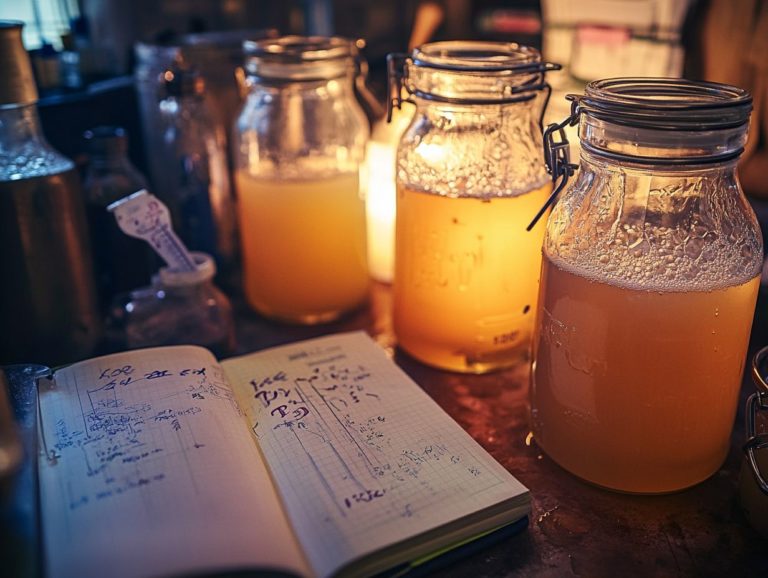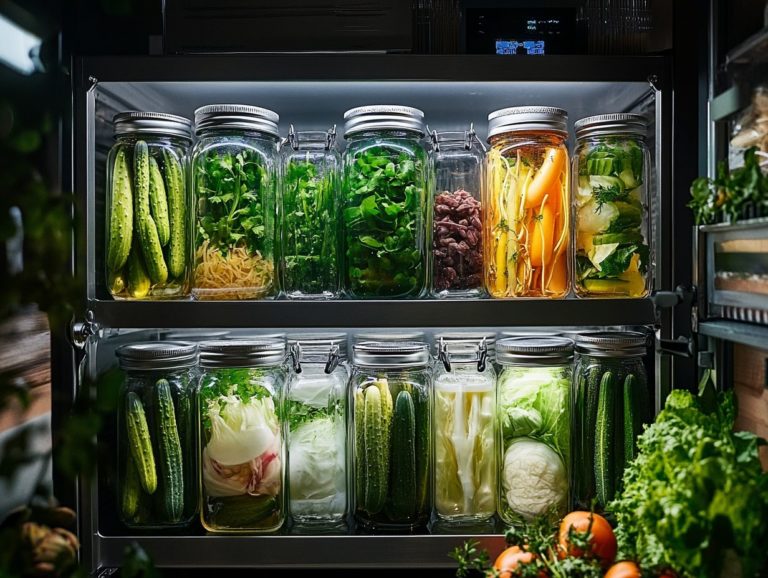5 Creative Fermentation Projects to Try
Contents
- Exploring the Art of Fermentation: Five Innovative Projects
- Key Takeaways:
- 1. Homemade Sourdough Bread
- 2. Fruit Kvass
- 3. Kombucha Brewing
- 4. Fermented Vegetables
- 5. Ginger Beer
- What Is Fermentation and Why Is It Beneficial?
- What Are the Basic Supplies Needed for Fermentation?
- Frequently Asked Questions
- What are some creative fermentation projects to try?
- Why is fermentation a popular food trend?
- What is the basic process of fermentation?
- Can you ferment foods at home without any special equipment?
- How long does it take to see results in a fermentation project?
- Are there any safety precautions to consider when fermenting food at home?
Exploring the Art of Fermentation: Five Innovative Projects
Fermentation transcends mere food preservation; it’s an art form that elevates flavors while enriching nutritional value. This process opens the door to countless exciting fermentation recipes that beginners and seasoned practitioners alike can enjoy.
This article invites you to explore five innovative fermentation projects, from crafting your own sourdough bread to whipping up a refreshing fruit kvass, or even experimenting with yogurt and dairy alternatives, all of which you can effortlessly embark on at home.
You ll delve into the fundamentals of fermentation, discover essential supplies, including a quick-start guide, and gather tips on seamlessly incorporating these delectable creations into your daily diet.
You will uncover common pitfalls to avoid and explore some intriguing, lesser-known fermentation ideas designed to spark your creativity. With creative recipes, you can experiment with unique ingredients such as jalape os, rhubarb, or even Mortier Pilon tools.
Key Takeaways:
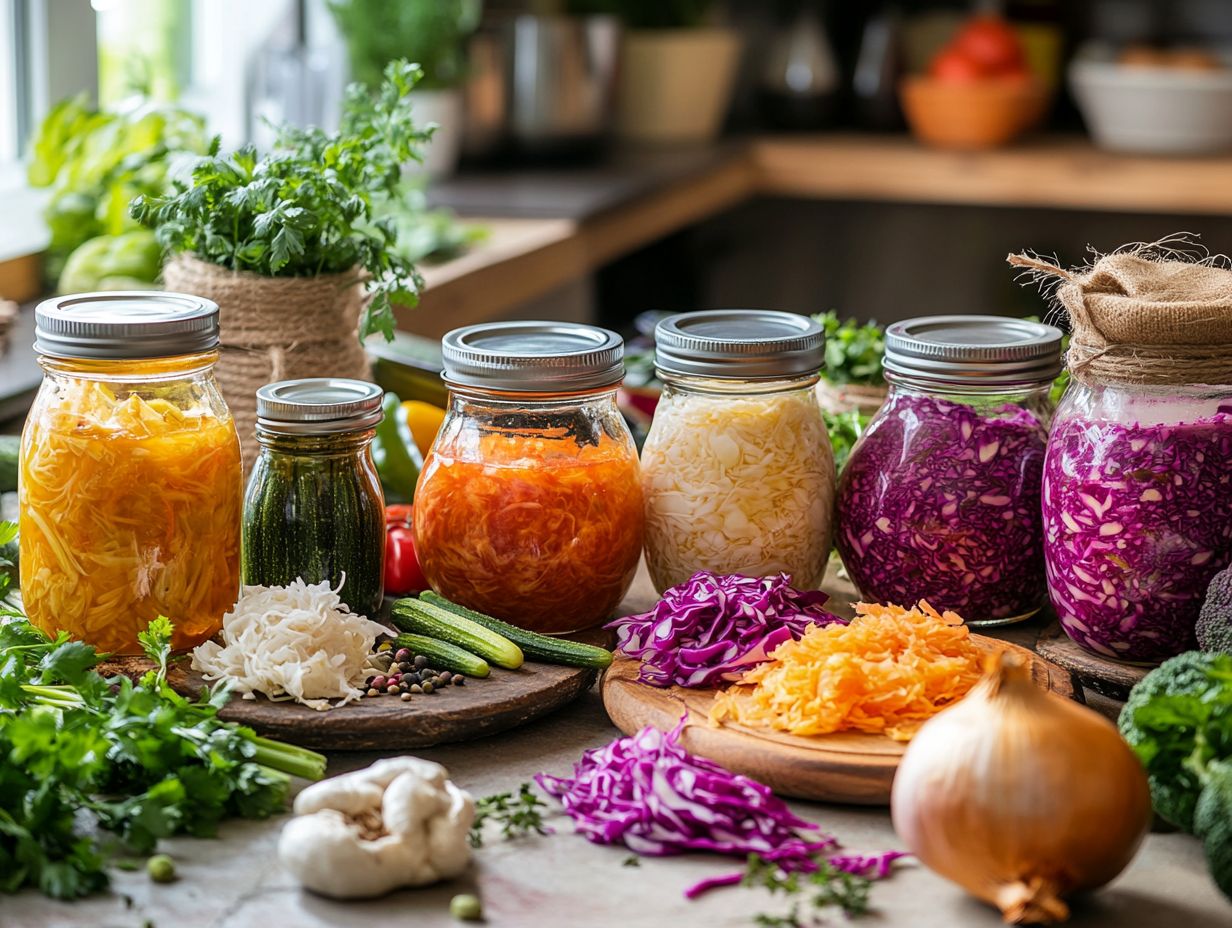
- Homemade sourdough bread is a delicious and satisfying fermentation project that only requires a few basic supplies to get started. Christopher Shockey and Kirsten Shockey have great resources on this topic.
- Fruit kvass and kombucha are two tasty and probiotic-rich beverages that can easily be made at home through fermentation, showcasing the potential of fermented foods.
- Fermented vegetables and ginger beer are great options for adding more fermented foods to your diet, providing numerous health benefits and unique flavors. You could also try making pickles or apple cider vinegar for more variety.
1. Homemade Sourdough Bread
Homemade sourdough bread embodies the true essence of fermentation, harnessing natural yeast and bacteria to craft a flavorful loaf that not only tantalizes your taste buds but also provides a wealth of health benefits. This is particularly thanks to its probiotic content, which refers to beneficial bacteria that support gut health.
This art of crafting fermented bread is both an ancient tradition and a contemporary culinary delight, inviting beginners like you to dive into the fascinating world of fermentation. For further reading, fermentation books by experts like Christopher Shockey and Kirsten Shockey can be invaluable.
What distinguishes sourdough from commercial bread is its lengthy fermentation time, which enhances the flavor profile and makes the bread easier to digest due to the breakdown of gluten and phytate. Phytate is a compound that can inhibit the absorption of certain minerals. If you re embarking on your sourdough journey, it s essential to gather a few key supplies, including:
- A sourdough starter
- A digital scale for precise measurements
- A Dutch oven for baking
You can also experiment with various flours, such as whole wheat or rye, to achieve distinct tastes and textures. Adding ingredients like herbs, nuts, or seeds can further elevate your loaf to new heights. With practice and a touch of patience, you ll find immense joy in the rewarding process of creating this nourishing staple.
2. Fruit Kvass
Fruit kvass is a delightful fermented beverage that allows you to explore the creative potential of fermentation, transforming simple fruits into a tangy, probiotic-rich drink. It s perfect for anyone looking into the world of fermented foods.
This traditional beverage, requiring minimal ingredients and effort, is not only refreshing but also brimming with health benefits and unique flavors. To craft fruit kvass, you typically start with ripe fruits, sugar, and water, which ferment over a few days, creating an environment for beneficial bacteria to flourish.
This drink doesn’t just offer a gut-friendly boost; it also serves as a natural, energizing alternative to sugary sodas. For those eager to embark on your fermentation journey, simple recipes like apple or beet kvass can yield delightful results.
The possibilities are endless you can experiment by incorporating various fruits and even vegetables, such as berries or carrots, allowing you to create unique flavor profiles.
Beyond its delicious taste, kvass carries cultural significance in many Eastern European countries, where it has been cherished for generations, symbolizing a deep connection to tradition and community.
3. Kombucha Brewing
Kombucha brewing offers a captivating entry into the realm of fermentation, where you ll blend tea and sugar with a symbiotic culture of bacteria and yeast (SCOBY) to craft a fizzy, probiotic-rich beverage. This delightful fermented drink comes with a host of health benefits. It not only tantalizes your taste buds with its distinctive flavors but also gives you the power to cultivate essential fermentation skills right in your own kitchen.
To embark on this flavorful adventure, you’ll need to gather some key supplies: a clean glass jar, filtered water, quality tea whether black or green and sugar to nourish your SCOBY. It s crucial to keep a close eye on the fermentation process. Letting it ferment too long can lead to overly sour flavors, while not letting it ferment enough might leave you with a lackluster fizz.
Flavoring your kombucha is a fun way to get creative. You can choose from fresh fruits, herbs, or even spices, allowing you to put your personal spin on each batch. Regularly sipping your homemade kombucha can offer various health perks, including improved digestion, enhanced immunity, and elevated energy levels. This makes it not just a delicious indulgence but a nourishing addition to your diet.
4. Fermented Vegetables
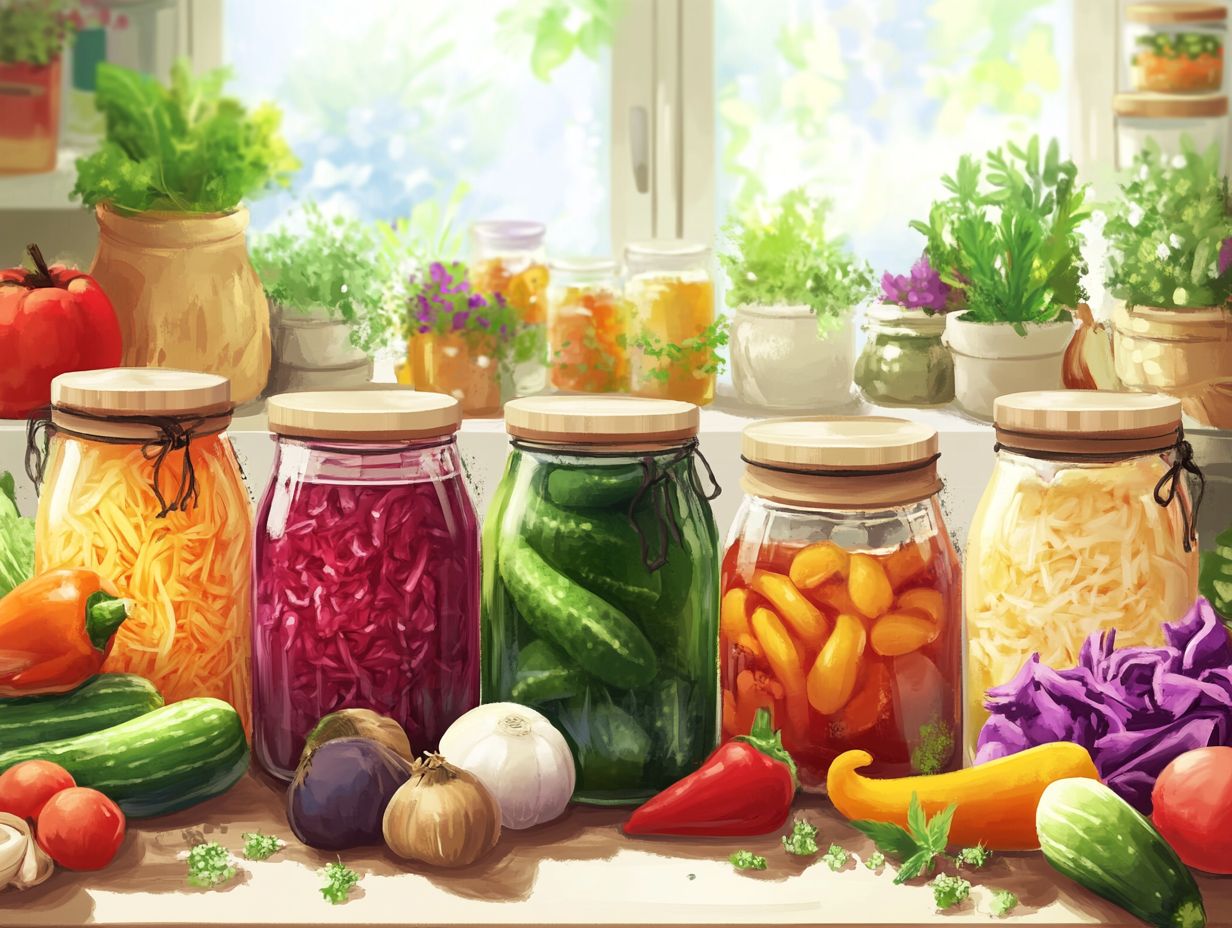
Fermented vegetables like sauerkraut and kimchi elevate your meals with their bold flavors while offering a treasure trove of probiotics and health benefits. They are essential staples in diets around the globe. The art of fermenting vegetables is both simple and gratifying, providing you with an opportunity to unleash your culinary creativity and enjoy the nutritious rewards that come from incorporating these foods into your daily fare.
By tapping into the power of beneficial bacteria, fermentation transforms ordinary vegetables into gut-friendly delights overflowing with vitamins and enzymes. As the natural sugars present in the vegetables ferment, they convert into lactic acid, serving as a natural preservative and imparting that signature tang that makes your taste buds dance.
As you embark on this culinary journey, consider starting with familiar options like cabbage for sauerkraut or a medley of greens and spices for kimchi. Opting for fresh, organic produce not only enhances the flavor but also boosts the nutritional value, ensuring that your final creation is both delicious and profoundly beneficial for your health.
5. Ginger Beer
Ginger beer is not only a household favorite but also a fascinating way to develop your fermentation skills. This drink, much like other fermented beverages, showcases the vast capabilities of fermentation.
You’ll be amazed at how easy it is to whip up this delightful concoction! Homemade ginger beer is a refreshingly tangy beverage that beautifully showcases the art of fermentation. With just ginger, sugar, and water, you can create a naturally fizzy drink that’s not only delicious but also packed with probiotics and a wealth of health benefits. This delightful concoction invites you to embrace the fermentation process while adding an exciting twist to your beverage repertoire.
To embark on this flavorful journey, all you need are fresh ginger, sugar, and water, along with a few essential tools like a clean jar, a stirring utensil, and a cloth to cover your mixture. As the fermentation unfolds, beneficial bacteria and yeasts flourish, bringing a natural effervescence and a host of gut-boosting properties to your creation.
The possibilities are endless why not consider adding lemon, lime, or even a touch of spice with chili for an exciting twist? If you find that fermentation stalls or your brew becomes overly fizzy, simply adjusting the sugar levels or temperature can help you troubleshoot these common issues, ensuring a perfect batch every time.
What Is Fermentation and Why Is It Beneficial?
Fermentation is a fascinating biological process where microorganisms, like bacteria and yeast, transform sugars into alcohol or acids. This process results in a variety of delicious fermented foods that offer significant health benefits, such as improved digestion and enhanced nutrient absorption.
This ancient technique not only preserves food but also enriches it with probiotics. Fermentation is a cornerstone of various global cuisines, from yogurt and kimchi to kombucha and sauerkraut. It creates an optimal environment for beneficial microorganisms to thrive, significantly enhancing the health benefits of the final product.
To truly appreciate fermentation, you need to recognize the vital roles these microorganisms play. They metabolize carbohydrates in low-oxygen environments, creating a delightful spectrum of flavors and textures. This process extends the shelf life of food and elevates its nutritional profile, making nutrients easier for your body to absorb.
Organizations, including various non-profit groups, have been instrumental in promoting the benefits of fermentation. They highlight its importance in both historical and modern contexts.
Fermented foods are abundant in probiotics those beneficial bacteria that support gut health. These little powerhouses help reduce digestive disorders and bolster your immune system. Culinary staples like miso in Japan and kefir in Eastern Europe showcase the global cultural significance of fermentation, illustrating how this time-honored practice remains essential to diets and traditions around the world.
For more insights and community discussions, check out the Satisfactory subreddit. It s a fantastic platform to engage with fellow fermentation enthusiasts!
What Are the Basic Supplies Needed for Fermentation?
Ready to dive into fermentation? You’ll need some basic supplies to get started! These tools will elevate your fermentation process and help you create delicious, probiotic-rich foods. Essential items include jars, fermentation weights, and lids. These provide the ideal environment for microorganisms to flourish, transforming your ingredients into vibrant, flavorful fermented delights.
As you embark on specific fermentation projects, unique tools may come into play. For example, crafting kombucha requires airlocks to prevent contamination while allowing gases to escape. If yogurt is on your agenda, sourcing quality starter cultures is key to achieving that perfect consistency and tanginess.
Beginners may benefit from using a quick-start guide to avoid common pitfalls. Don’t wait too long to gather your tools! The sooner you start, the sooner you can enjoy homemade fermented goodies.
Check out your local health food stores or explore online specialty retailers for these supplies; both can be excellent resources. It’s crucial to regularly inspect and maintain your fermentation equipment. Non-profit organizations often offer resources and workshops to help you get started.
Ensure that all jars are properly sterilized and stored in a cool, dark place to optimize fermentation conditions and enhance the quality of your final product.
How Can One Incorporate Fermented Foods into Their Diet?
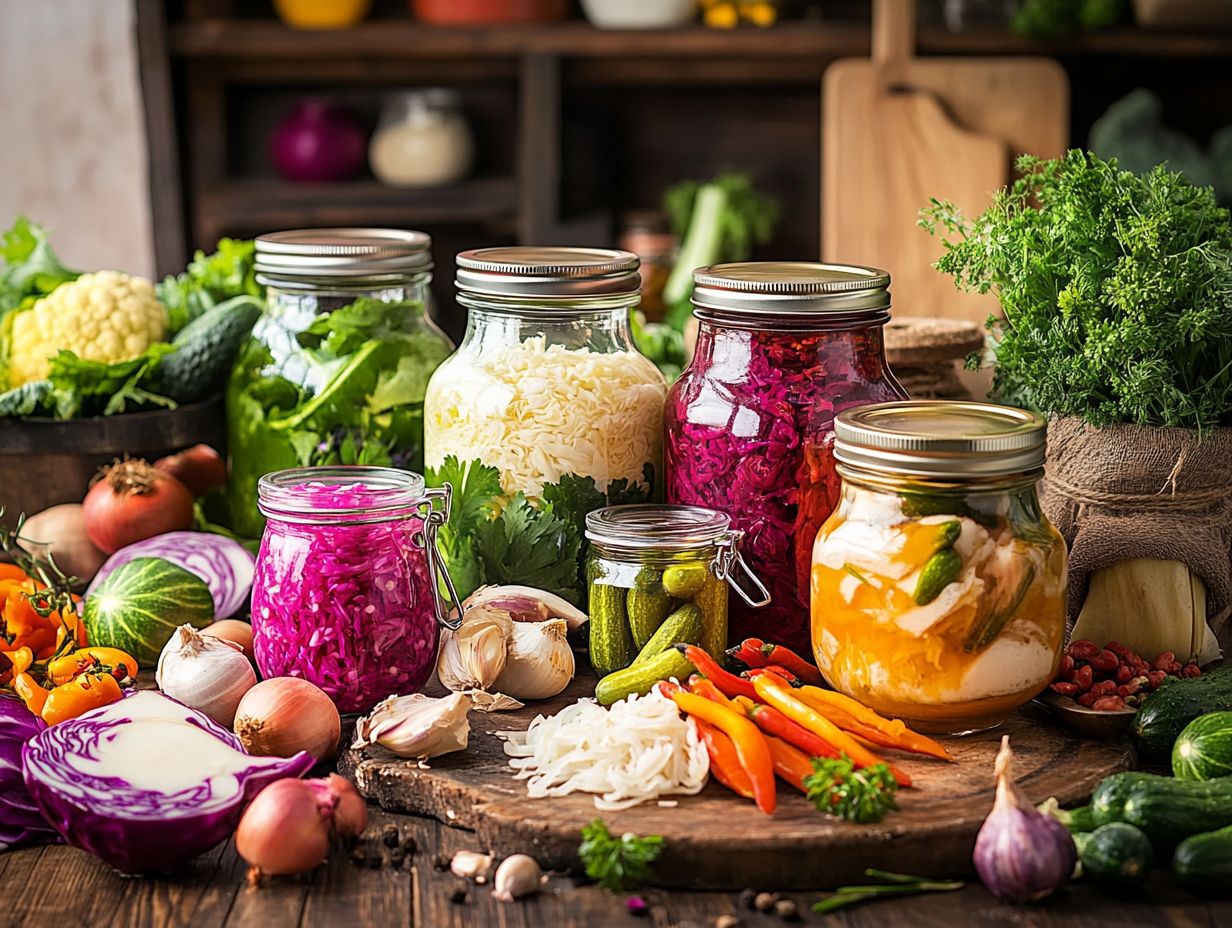
Start your journey with fermented foods today and unlock amazing flavors and health benefits! Incorporating fermented foods into your diet can be an exciting journey that elevates your meals with bold flavors and offers a plethora of health benefits, such as improved gut health and a boost in probiotic intake.
Picture yourself savoring tangy sauerkraut or indulging in creamy yogurt. There are countless creative recipes that make adding these nutritious foods both effortless and delectable.
For instance, why not toss some kimchi into your stir-fries for an exhilarating spicy kick? Or use yogurt as a delightful base for smoothies that deliver a probiotic punch along with vibrant fruits. You could even add apple cider vinegar for an extra health kick. Pickles can also serve as a refreshing snack, satisfying your cravings while promoting digestive health.
To truly embrace these fermented delights, consider trying fermentation recipes like a yogurt parfait layered with fresh berries and granola. You could also make a zesty kimchi fried rice that turns leftovers into a lively feast. Exploring the cultural significance of these dishes can enrich your culinary appreciation.
By regularly incorporating these foods into your diet, you can enhance your culinary variety. This will also boost your overall wellness.
What Are the Common Mistakes to Avoid When Fermenting?
As a beginner in fermentation, you might find yourself stumbling upon common pitfalls that could hinder your success. Issues such as improper ingredient ratios, subpar fermentation environments, and lapses in sanitation can lead to disappointing results.
Recognizing these challenges and mastering the fermentation process will allow you to consistently create delicious, safe, and rich in probiotics fermented foods while honing your fermentation skills.
One of the most common missteps is failing to measure your ingredients accurately, which can disrupt the delicate balance of flavors and fermentation activity. Maintaining a consistent temperature throughout the fermentation period is crucial; fluctuations can lead to unpredictable microbial growth, which is the natural process of fermentation.
It s equally important to keep your workspace immaculate, ensuring that all equipment and jars are thoroughly sanitized. Even the slightest bit of contamination can spoil your hard work. Make it a habit to inspect your ferments regularly for any off-putting smells or unexpected textures. Catching these issues early allows you to make adjustments that could save your culinary endeavor. Using high-quality dairy can also significantly impact the success of your fermentations.
How Can One Get Creative with Fermentation?
Exploring the creative possibilities of fermentation invites you to experiment with a delightful array of ingredients and flavor combinations, ranging from zesty spiced pickles to exotic fruit kvass. The health benefits of these creations can be substantial, contributing to your overall wellness.
This journey not only enriches your culinary skills but also enhances your meals in ways you might not have imagined. Embracing the cultural significance of fermented foods can deepen your appreciation for this craft.
Imagine the thrill of incorporating unconventional ingredients, such as jalape os in your pickles for a fiery kick, or experimenting with rhubarb in kvass for a uniquely tangy twist. You might also try adding ginger beer to your list of experiments for a refreshing twist. These daring choices can unlock a treasure trove of flavors that you may not have previously explored.
As you embark on this flavorful adventure, remember the importance of closely monitoring your ferments and adjusting ratios to achieve the results you desire while ensuring safety. Documenting your experiments is essential; keeping track of what works and what doesn t will help you cultivate your unique fermentation journey and revel in the unexpected joys it can bring.
Dive into your own fermentation adventure today and discover flavors you ve never imagined!
What Are Some Lesser-Known Fermentation Projects to Try?
Diving into the world of lesser-known fermentation projects, such as crafting miso, tempeh, or various dairy alternatives, can be an exhilarating way to expand your culinary repertoire. Experimenting with fruits in your projects adds delightful dimensions to your creations.
These endeavors introduce you to a medley of unique flavors and textures while offering a wealth of health benefits that come with fermented foods.
The art of fermentation boasts ancient roots, with techniques lovingly passed down through generations. This tradition cultivates beneficial bacteria that aid digestion and boost your immune system.
Fermentation books by authors such as Christopher Shockey and Kirsten Shockey provide valuable insights.
If you re just starting out, beginner-friendly recipes for homemade sauerkraut or yogurt are perfect introductions to this fascinating craft. Consider using products from Mortier Pilon to enhance your fermentation experience.
Track your fermentation journey through journaling; it s a great way to pinpoint what works best for your taste and consistency preferences.
Tapping into resources like community workshops or online forums such as the Satisfactory subreddit can stoke your creativity and create connections with fellow fermentation enthusiasts.
This culinary adventure is going to be fun and rewarding!
Frequently Asked Questions
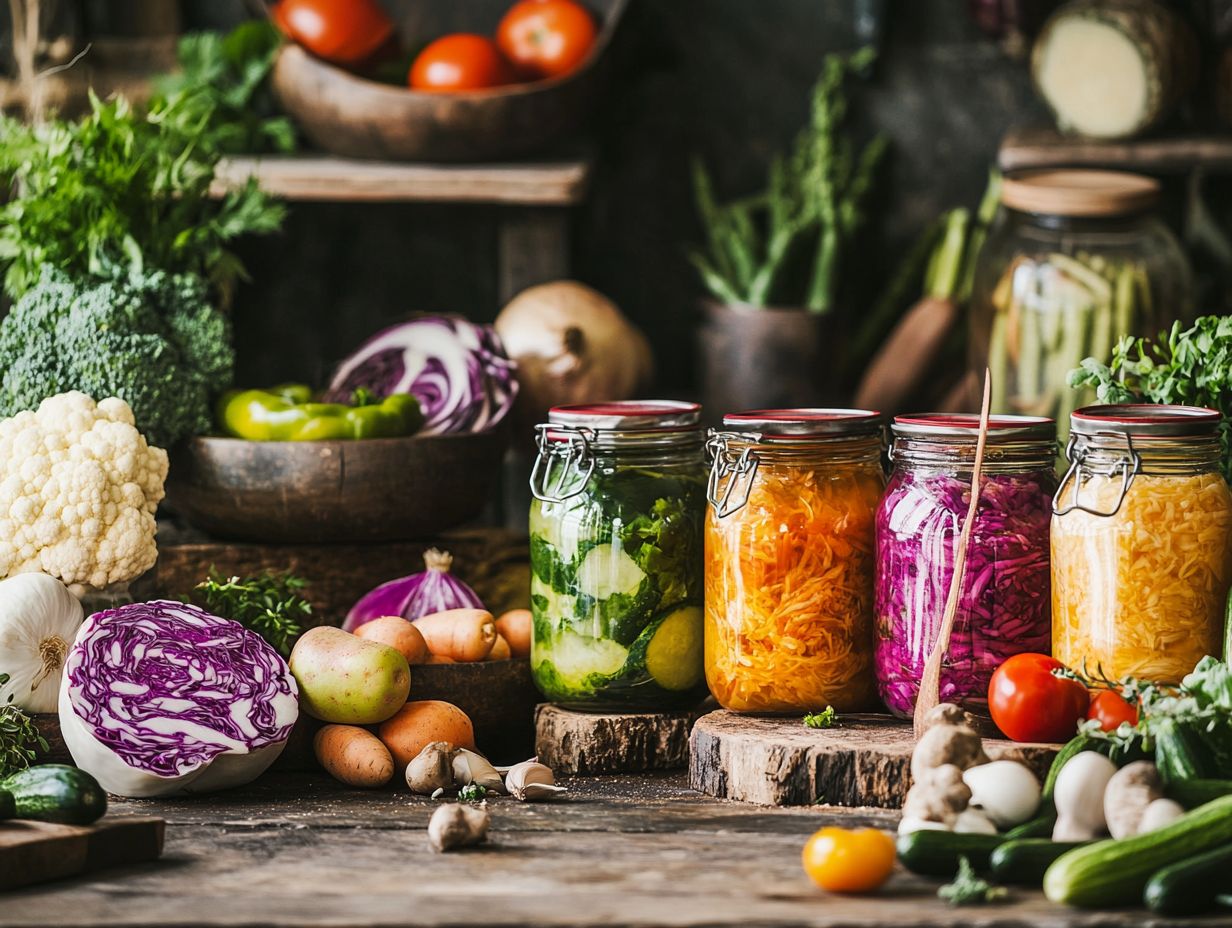
What are some creative fermentation projects to try?
Some creative fermentation projects include making homemade kombucha, fermenting vegetables like sauerkraut or kimchi, brewing your own beer or mead, making fermented hot sauce, and experimenting with dairy-free yogurt.
Why is fermentation a popular food trend?
Fermentation is popular because it has numerous health benefits, including improving digestion, increasing nutrient absorption, and boosting the immune system. It also allows for unique and complex flavors in food and drinks.
What is the basic process of fermentation?
The basic process of fermentation involves using microorganisms like bacteria or yeast to break down sugars in food, creating lactic acid or alcohol. This process preserves food, adds good bacteria that help your gut, and enhances flavors.
Can you ferment foods at home without any special equipment?
Yes, many fermentation projects can be done at home without special equipment. For example, sauerkraut can be fermented in a mason jar, and kombucha can be made using a glass jar covered with cloth.
How long does it take to see results in a fermentation project?
The time to see results can vary depending on the food being fermented and the environment’s temperature. Generally, it can take anywhere from a few days to a few weeks to notice changes and complete the fermentation process.
Are there any safety precautions to consider when fermenting food at home?
Yes, consider the following safety precautions: use clean utensils and containers, and monitor the fermentation process closely. Proper sanitation is essential to avoid contamination. Be aware of signs of spoilage, such as mold growth or off-putting odors.


